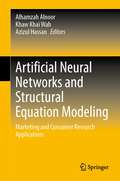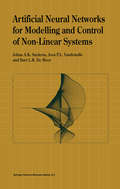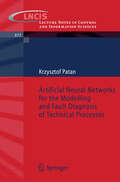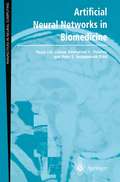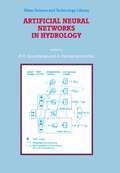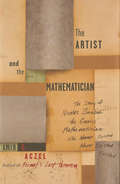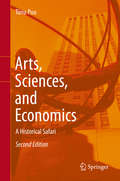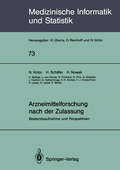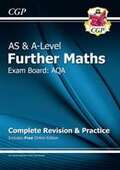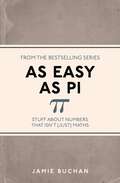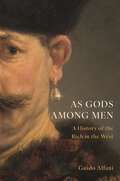- Table View
- List View
Artificial Neural Networks and Structural Equation Modeling: Marketing and Consumer Research Applications
by Alhamzah Alnoor Khaw Khai Wah Azizul HassanThis book goes into a detailed investigation of adapting artificial neural network (ANN) and structural equation modeling (SEM) techniques in marketing and consumer research. The aim of using a dual-stage SEM and ANN approach is to obtain linear and non-compensated relationships because the ANN method captures non-compensated relationships based on the black box technology of artificial intelligence. Hence, the ANN approach validates the results of the SEM method. In addition, such the novel emerging approach increases the validity of the prediction by determining the importance of the variables. Consequently, the number of studies using SEM-ANN has increased, but the different types of study cases that show customization of different processes in ANNs method combination with SEM are still unknown, and this aspect will be affecting to the generation results. Thus, there is a need for further investigation in marketing and consumer research. This book bridges the significant gap in this research area. The adoption of SEM and ANN techniques in social commerce and consumer research is massive all over the world. Such an expansion has generated more need to learn how to capture linear and non-compensatory relationships in such area. This book would be a valuable reading companion mainly for business and management students in higher academic organizations, professionals, policy-makers, and planners in the field of marketing. This book would also be appreciated by researchers who are keenly interested in social commerce and consumer research.
Artificial Neural Networks for Engineers and Scientists: Solving Ordinary Differential Equations
by S. Chakraverty Susmita MallDifferential equations play a vital role in the fields of engineering and science. Problems in engineering and science can be modeled using ordinary or partial differential equations. Analytical solutions of differential equations may not be obtained easily, so numerical methods have been developed to handle them. Machine intelligence methods, such as Artificial Neural Networks (ANN), are being used to solve differential equations, and these methods are presented in Artificial Neural Networks for Engineers and Scientists: Solving Ordinary Differential Equations. This book shows how computation of differential equation becomes faster once the ANN model is properly developed and applied.
Artificial Neural Networks for Engineers and Scientists: Solving Ordinary Differential Equations
by S. Chakraverty Susmita MallDifferential equations play a vital role in the fields of engineering and science. Problems in engineering and science can be modeled using ordinary or partial differential equations. Analytical solutions of differential equations may not be obtained easily, so numerical methods have been developed to handle them. Machine intelligence methods, such as Artificial Neural Networks (ANN), are being used to solve differential equations, and these methods are presented in Artificial Neural Networks for Engineers and Scientists: Solving Ordinary Differential Equations. This book shows how computation of differential equation becomes faster once the ANN model is properly developed and applied.
Artificial Neural Networks for Modelling and Control of Non-Linear Systems
by Johan A.K. Suykens Joos P.L. Vandewalle B.L. de MoorArtificial neural networks possess several properties that make them particularly attractive for applications to modelling and control of complex non-linear systems. Among these properties are their universal approximation ability, their parallel network structure and the availability of on- and off-line learning methods for the interconnection weights. However, dynamic models that contain neural network architectures might be highly non-linear and difficult to analyse as a result. Artificial Neural Networks for Modelling and Control of Non-Linear Systems investigates the subject from a system theoretical point of view. However the mathematical theory that is required from the reader is limited to matrix calculus, basic analysis, differential equations and basic linear system theory. No preliminary knowledge of neural networks is explicitly required. The book presents both classical and novel network architectures and learning algorithms for modelling and control. Topics include non-linear system identification, neural optimal control, top-down model based neural control design and stability analysis of neural control systems. A major contribution of this book is to introduce NLq Theory as an extension towards modern control theory, in order to analyze and synthesize non-linear systems that contain linear together with static non-linear operators that satisfy a sector condition: neural state space control systems are an example. Moreover, it turns out that NLq Theory is unifying with respect to many problems arising in neural networks, systems and control. Examples show that complex non-linear systems can be modelled and controlled within NLq theory, including mastering chaos. The didactic flavor of this book makes it suitable for use as a text for a course on Neural Networks. In addition, researchers and designers will find many important new techniques, in particular NLq Theory, that have applications in control theory, system theory, circuit theory and Time Series Analysis.
Artificial Neural Networks for the Modelling and Fault Diagnosis of Technical Processes (Lecture Notes in Control and Information Sciences #Vol. 377)
by Krzysztof PatanAn unappealing characteristic of all real-world systems is the fact that they are vulnerable to faults, malfunctions and, more generally, unexpected modes of - haviour. This explains why there is a continuous need for reliable and universal monitoring systems based on suitable and e?ective fault diagnosis strategies. This is especially true for engineering systems,whose complexity is permanently growing due to the inevitable development of modern industry as well as the information and communication technology revolution. Indeed, the design and operation of engineering systems require an increased attention with respect to availability, reliability, safety and fault tolerance. Thus, it is natural that fault diagnosis plays a fundamental role in modern control theory and practice. This is re?ected in plenty of papers on fault diagnosis in many control-oriented c- ferencesand journals.Indeed, a largeamount of knowledgeon model basedfault diagnosis has been accumulated through scienti?c literature since the beginning of the 1970s. As a result, a wide spectrum of fault diagnosis techniques have been developed. A major category of fault diagnosis techniques is the model based one, where an analytical model of the plant to be monitored is assumed to be available.
Artificial Neural Networks in Biomedicine (Perspectives in Neural Computing)
by Paulo J. G. Lisboa Emmanuel C. Ifeachor Piotr S. SzczepaniakFollowing the intense research activIties of the last decade, artificial neural networks have emerged as one of the most promising new technologies for improving the quality of healthcare. Many successful applications of neural networks to biomedical problems have been reported which demonstrate, convincingly, the distinct benefits of neural networks, although many ofthese have only undergone a limited clinical evaluation. Healthcare providers and developers alike have discovered that medicine and healthcare are fertile areas for neural networks: the problems here require expertise and often involve non-trivial pattern recognition tasks - there are genuine difficulties with conventional methods, and data can be plentiful. The intense research activities in medical neural networks, and allied areas of artificial intelligence, have led to a substantial body of knowledge and the introduction of some neural systems into clinical practice. An aim of this book is to provide a coherent framework for some of the most experienced users and developers of medical neural networks in the world to share their knowledge and expertise with readers.
Artificial Neural Networks in Hydrology (Water Science and Technology Library #36)
by R. S. Govindaraju A. R. RaoR. S. GOVINDARAJU and ARAMACHANDRA RAO School of Civil Engineering Purdue University West Lafayette, IN. , USA Background and Motivation The basic notion of artificial neural networks (ANNs), as we understand them today, was perhaps first formalized by McCulloch and Pitts (1943) in their model of an artificial neuron. Research in this field remained somewhat dormant in the early years, perhaps because of the limited capabilities of this method and because there was no clear indication of its potential uses. However, interest in this area picked up momentum in a dramatic fashion with the works of Hopfield (1982) and Rumelhart et al. (1986). Not only did these studies place artificial neural networks on a firmer mathematical footing, but also opened the dOOf to a host of potential applications for this computational tool. Consequently, neural network computing has progressed rapidly along all fronts: theoretical development of different learning algorithms, computing capabilities, and applications to diverse areas from neurophysiology to the stock market. . Initial studies on artificial neural networks were prompted by adesire to have computers mimic human learning. As a result, the jargon associated with the technical literature on this subject is replete with expressions such as excitation and inhibition of neurons, strength of synaptic connections, learning rates, training, and network experience. ANNs have also been referred to as neurocomputers by people who want to preserve this analogy.
Artificial Neural Networks in Medicine and Biology: Proceedings of the ANNIMAB-1 Conference, Göteborg, Sweden, 13–16 May 2000 (Perspectives in Neural Computing)
by H. Malmgren L. Niklasson M. BorgaThis book contains the proceedings of the conference ANNIMAB-l, held 13-16 May 2000 in Goteborg, Sweden. The conference was organized by the Society for Artificial Neural Networks in Medicine and Biology (ANNIMAB-S), which was established to promote research within a new and genuinely cross-disciplinary field. Forty-two contributions were accepted for presentation; in addition to these, S invited papers are also included. Research within medicine and biology has often been characterised by application of statistical methods for evaluating domain specific data. The growing interest in Artificial Neural Networks has not only introduced new methods for data analysis, but also opened up for development of new models of biological and ecological systems. The ANNIMAB-l conference is focusing on some of the many uses of artificial neural networks with relevance for medicine and biology, specifically: • Medical applications of artificial neural networks: for better diagnoses and outcome predictions from clinical and laboratory data, in the processing of ECG and EEG signals, in medical image analysis, etc. More than half of the contributions address such clinically oriented issues. • Uses of ANNs in biology outside clinical medicine: for example, in models of ecology and evolution, for data analysis in molecular biology, and (of course) in models of animal and human nervous systems and their capabilities. • Theoretical aspects: recent developments in learning algorithms, ANNs in relation to expert systems and to traditional statistical procedures, hybrid systems and integrative approaches.
Artificial Neural Networks in Vehicular Pollution Modelling (Studies in Computational Intelligence #41)
by Mukesh Khare S.M. Shiva NagendraThis book provides a step-by-step procedure for formulation and development of Artificial Neural Networks based Vehicular pollution models. It takes into account meteorological and traffic aspects. The book will be useful for professionals and researchers working in problems associated with urban air pollution management and control
Artificial Superintelligence: A Futuristic Approach
by Roman V. YampolskiyA day does not go by without a news article reporting some amazing breakthrough in artificial intelligence (AI). Many philosophers, futurists, and AI researchers have conjectured that human-level AI will be developed in the next 20 to 200 years. If these predictions are correct, it raises new and sinister issues related to our future in the age of
Artificial Superintelligence: A Futuristic Approach
by Roman V. YampolskiyA day does not go by without a news article reporting some amazing breakthrough in artificial intelligence (AI). Many philosophers, futurists, and AI researchers have conjectured that human-level AI will be developed in the next 20 to 200 years. If these predictions are correct, it raises new and sinister issues related to our future in the age of
Artinian Modules over Group Rings (Frontiers in Mathematics)
by Leonid Kurdachenko Javier Otal Igor Ya SubbotinThis book highlights important developments on artinian modules over group rings of generalized nilpotent groups. Along with traditional topics such as direct decompositions of artinian modules, criteria of complementability for some important modules, and criteria of semisimplicity of artinian modules, it also focuses on recent advanced results on these matters.
The Artist and the Mathematician: The Story Of Nicolas Bourbaki, The Genius Mathematician Who Never Existed
by Amir D. AczelNicolas Bourbaki, whose mathematical publications began to appear in the late 1930s and continued to be published through most of the twentieth century, was a direct product as well as a major force behind an important revolution that took place in the early decades of the twentieth century that completely changed Western culture. Pure mathematics, the area of Bourbaki's work, seems on the surface to be an abstract field of human study with no direct connection with the real world. In reality, however, it is closely intertwined with the general culture that surrounds it. Major developments in mathematics have often followed important trends in popular culture; developments in mathematics have acted as harbingers of change in the surrounding human culture. The seeds of change, the beginnings of the revolution that swept the Western world in the early decades of the twentieth century - both in mathematics and in other areas - were sown late in the previous century. This is the story both of Bourbaki and the world that created him in that time. It is the story of an elaborate intellectual joke - because Bourbaki, one of the foremost mathematicians of his day - never existed.
Arto Salomaa: A Thematic Biography
by Jukka PaakkiThis book outlines the scientific career of Arto Salomaa, a pioneer in theoretical computer science and mathematics. The author first interviewed the subject and his family and collaborators, and he then researched this fascinating biography of an intellectual who was key in the development of these fields.Early chapters progress chronologically from Academician Salomaa's origins, childhood, and education to his professional successes in science, teaching, and publishing. His most impactful direct research efforts have been in the areas of automata and formal languages. Beyond that he has influenced many more scientists and professionals through collaborations, teaching, and books on topics such as biocomputing and cryptography. The author offers insights into Finnish history, culture, and academia, while historians of computer science will appreciate the vignettes describing some of the people who have shaped the field from the 1950s to today. The author and his subject return throughout to underlying themes such as the importance of family and the value of longstanding collegial relationships, while the work and achievements are leavened with humor and references to interests such as music, sport, and the sauna.
Arts, Sciences, and Economics: A Historical Safari
by Tönu PuuThis book deals with the economic aspects of changing attitudes in arts and sciences. The effects of the public good character of culture, along with the very long production period and lifetime for its products, are emphasized, since both contribute to the failure of normal market solutions. Embodiment of ideas and the consequences of modern reproduction technology for protection of property rights are closely examined.The evolution within arts and sciences, which often seems to return to previously scrapped ideals, is illustrated by detailed case studies, in which the importance of changing tastes, rather than progress proper, is emphasized.The author attempts an understanding for this using Darwinian evolution in combination with modern mathematical complexity theory, expressed in terms accessible to the general reader.The second edition is extended and updated especially as regards the illustration material.
Arzneimittelforschung nach der Zulassung: Bestandsaufnahme und Perspektiven (Medizinische Informatik, Biometrie und Epidemiologie #73)
by N. Victor H. Schäfer H. Nowak H. Bethge L. von Ferber R. Fimmers H. Fink G. Glaeske J. Hasford G. Kallischnigg K.H. Kimbel F.-J. Kretschmer R. Lasek H. Letzel E. WeberDie klinische Prüfung von Arzneimitteln vor der Zulassung hat einen hohen wissenschaftlichen Standard erreicht. Das vorliegende Buch macht deutlich, daß diese Forschungsphase aufgrund der zeitlichen Limitierung dennoch keine abschließenden Ergebnisse hinsichtlich Wirksamkeit und Sicherheit eines Arzneimittels liefern kann. Eine kontinuierliche begleitende Forschung auch nach der Zulassung eines Arzneimittels ist daher unabdingbar und liegt gleichermaßen im Interesse von Patienten, Ärzten und Arzneimittelherstellern. In umfassender und systematischer Weise wird die Vielfalt der Fragestellungen einer Arzneimittelforschung nach der Zulassung herausgearbeitet und deutlich gemacht, daß nur eine erhebliche Ausweitung des Methodenspektrums über die bekannten Methoden hinaus diesen Anforderungen gerecht werden kann. Das Buch bietet eine systematische Beschreibung der wichtigsten methodischen Instrumente, wobei besonders ausführlich die Studienform und Methoden der sog. Pharmakoepidemiologie behandelt werden, für die bisher keine Verfahrensrichtlinien und Qualitätsnormen existierten. Zahlreiche Wissenschaftler und Experten aus den Bereichen Biometrie, Pharmakologie und Innere Medizin haben zu diesem Buch beigetragen. Es ist die bisher einzige so umfassende und systematische Darstellung des Themas "Arzneimittelforschung nach der Zulassung" in der deutschsprachigen Fachliteratur. Die Realisierung des aufgezeigten Forschungsbedarfs nach der Zulassung eines Arzneimittels bei Arzneimittelherstellern, der Ärzteschaft, Behörden und Forschungseinrichtungen und der sachgerechte Einsatz des in diesem Buch beschriebenen Methodenrepertoires kann einen wesentlichen Beitrag zur Erhöhung der Arzneimittelsicherheit leisten.
Arztgeheimnis — Datenbanken — Datenschutz: Arbeitstagung, Bad Homburg, 1982 (Medizinische Informatik, Biometrie und Epidemiologie #38)
by P. L. Reichertz W. KilianDrei Jahre sind vergangen, seit im Januar 1979 auf einer Arbeitstagung der Deutschen Gesellschaft für Medizinische Dokumentation, Informatik und Statistik e.V. (GMDS) und der Gesellschaft für Rechts- und Verwal tungsinformatik e.V. (GRVI) juristische Probleme der Datenverarbeitung in der Medizin diskutiert wurden. Die Ergebnisse dieser Veranstaltung, welche in der gleichen Reihe veröffentlicht worden sind (Band 12; Kilian, W., Porth, A.J.: Juristische Probleme der Datenverarbeitung in der Medizin, Springer-Verlag, Berlin/Heidelberg, 1979), fanden großes Interesse und dienten als Anregung für weitere Diskussionen. In der Zwischenzeit liegen Erfahrungen mit dem Datenschutz in der Medi zin vor. Die Jahresberichte der Datenschutzbeauftragten beleuchten zu nehmend diesen Aspekt. Darüber hinaus haben neue Gesetze (z.B. Sozial gesetzbuch), Gesetzentwürfe (z.B. Krebsregistergesetz) und Änderungen im ärztlichen Berufsrecht (Schweigepflicht und medizinische Forschung) die Diskussionen über den Datenfluß im medizinischen Bereich und dessen Kontrolle belebt. So erschien die erneute Veranstaltung einer Arbeits tagung sinnvoll. Sie wurde von den Herausgebern des Sammelbandes orga nisiert und von GMDS und GRVI sowie der gemeinsamen Kommission unter stützt. Der Aufbau der einzelnen Beiträge ist etwas unterschiedlich, da der Stand der weiteren Ausarbeitung der Referate variiert. Teilweise sind die Referate als Thesenpapier zusammengestellt, teilweise stellen sie tiefergehende Ausarbeitungen der Problematik dar. Im Gegensatz zu dem früheren Tagungsband oblag die Herstellung der Manuskripte den Autoren selbst. Daraus mag ein hin und wieder etwas unterschiedliches Druckbild resultieren; den Herausgebern schien es wichtig, daß der Tagungsband zu den aktuellen Problemen schnell erscheinen konnte.
AS & A-Level Further Maths for AQA: Complete Revision & Practice with Online Edition (PDF)
by CgpThis brilliant CGP Complete Revision & Practice book is a clear and concise guide to AS & A-Level AQA Further Maths. It’s packed with essential revision notes and worked examples for the Compulsory Content topics, as well as the Mechanics, Statistics and Discrete options. There are also plenty of exam-style questions to test students on what they’ve learned (including step-by-step answers at the back). And to top things off, the book comes with a free Online Edition - just use the code printed inside the book to read it on a PC, Mac or tablet.
AS and A Level Maths For Dummies
by Colin BeveridgePass your AS & A level maths with flying colours Looking to pass your AS and A level maths? Look no further. AS & A Level Maths For Dummies offers detailed, simple steps for all of the main types of problems you'll face in your exams, offering explanations of how the topics link together, advice on how to remember the key facts and methods, and ways to structure revision. Even if your head is spinning and you don't know where to begin, this fun and friendly guide gives in-depth support on exactly what you need to know. In the big data and digital age, maths skills have never been more important to career success. AS & A Level Maths For Dummies guides you through the skills needed to pass the exams taken at the end of the first and second year of the course. It begins with the knowledge needed to get a top grade at GCSE, followed by sections on Algebra (functions, graph-sketching, and logarithms), Geometry (coordinate geometry, trigonometry, and working with shapes) and Calculus (differentiation, integration, and differential equations). Helps you build the confidence you need to pass your exams Serves as an excellent supplement to classroom learning Makes difficult maths concepts easy to understand Offers in-depth support in a fun and friendly style If you're an AS & A level student looking to do your very best at exam time, AS & A Level Maths For Dummies makes it easier.
AS and A Level Maths For Dummies
by Colin BeveridgePass your AS & A level maths with flying colours Looking to pass your AS and A level maths? Look no further. AS & A Level Maths For Dummies offers detailed, simple steps for all of the main types of problems you'll face in your exams, offering explanations of how the topics link together, advice on how to remember the key facts and methods, and ways to structure revision. Even if your head is spinning and you don't know where to begin, this fun and friendly guide gives in-depth support on exactly what you need to know. In the big data and digital age, maths skills have never been more important to career success. AS & A Level Maths For Dummies guides you through the skills needed to pass the exams taken at the end of the first and second year of the course. It begins with the knowledge needed to get a top grade at GCSE, followed by sections on Algebra (functions, graph-sketching, and logarithms), Geometry (coordinate geometry, trigonometry, and working with shapes) and Calculus (differentiation, integration, and differential equations). Helps you build the confidence you need to pass your exams Serves as an excellent supplement to classroom learning Makes difficult maths concepts easy to understand Offers in-depth support in a fun and friendly style If you're an AS & A level student looking to do your very best at exam time, AS & A Level Maths For Dummies makes it easier.
As Easy As Pi: Stuff about numbers that isn't (just) maths (I Used to Know That #11)
by Jamie BuchanIt's hard to imagine a world without numbers in this day and age, when our whole life is centered around commerce and money, and it is the only language that is the same the world over. However, did you know that for a long period of time people could not get their heads around the idea of zero, a figure representing nothing, and that it was even regarded as heretical in some circles? As Easy As Pi is an entertaining and accessible guide, written for those who love numbers - and those who don't - and uncovers a great deal of lore and intriguing information. Including: Snippets of fascinating numerical facts Myths and mysticism in the world of numbers Numbers in language and used as slang Pop-culture trivia Useful mathematical rules to rememberTaking a quirky and insightful look at the world of numbers, As Easy As Pi will delight and entertain any number enthusiast.
As Gods Among Men: A History of the Rich in the West
by Guido AlfaniHow the rich and the super-rich throughout Western history accumulated their wealth, behaved (or misbehaved) and helped (or didn&’t help) their communities in times of crisis The rich have always fascinated, sometimes in problematic ways. Medieval thinkers feared that the super-rich would act 'as gods among men&’; much more recently Thomas Piketty made wealth central to discussions of inequality. In this book, Guido Alfani offers a history of the rich and super-rich in the West, examining who they were, how they accumulated their wealth and what role they played in society. Covering the last thousand years, with frequent incursions into antiquity, and integrating recent research on economic inequality, Alfani finds—despite the different paths to wealth in different eras—fundamental continuities in the behaviour of the rich and public attitudes towards wealth across Western history. His account offers a novel perspective on current debates about wealth and income disparity.Alfani argues that the position of the rich and super-rich in Western society has always been intrinsically fragile; their very presence has inspired social unease. In the Middle Ages, an excessive accumulation of wealth was considered sinful; the rich were expected not to appear to be wealthy. Eventually, the rich were deemed useful when they used their wealth to help their communities in times of crisis. Yet in the twenty-first century, Alfani points out, the rich and the super-rich—their wealth largely preserved through the Great Recession and COVID-19—have been exceptionally reluctant to contribute to the common good in times of crisis, rejecting even such stopgap measures as temporary tax increases. History suggests that this is a troubling development—for the rich, and for everyone else.
As Gods Among Men: A History of the Rich in the West
by Guido AlfaniHow the rich and the super-rich throughout Western history accumulated their wealth, behaved (or misbehaved) and helped (or didn&’t help) their communities in times of crisis The rich have always fascinated, sometimes in problematic ways. Medieval thinkers feared that the super-rich would act 'as gods among men&’; much more recently Thomas Piketty made wealth central to discussions of inequality. In this book, Guido Alfani offers a history of the rich and super-rich in the West, examining who they were, how they accumulated their wealth and what role they played in society. Covering the last thousand years, with frequent incursions into antiquity, and integrating recent research on economic inequality, Alfani finds—despite the different paths to wealth in different eras—fundamental continuities in the behaviour of the rich and public attitudes towards wealth across Western history. His account offers a novel perspective on current debates about wealth and income disparity.Alfani argues that the position of the rich and super-rich in Western society has always been intrinsically fragile; their very presence has inspired social unease. In the Middle Ages, an excessive accumulation of wealth was considered sinful; the rich were expected not to appear to be wealthy. Eventually, the rich were deemed useful when they used their wealth to help their communities in times of crisis. Yet in the twenty-first century, Alfani points out, the rich and the super-rich—their wealth largely preserved through the Great Recession and COVID-19—have been exceptionally reluctant to contribute to the common good in times of crisis, rejecting even such stopgap measures as temporary tax increases. History suggests that this is a troubling development—for the rich, and for everyone else.
AS-Level Maths for Edexcel - Core 2: Student Book (PDF)
by Cgp BooksThis student-friendly textbook for the Core 2 Module of A-Level Maths comprehensively covers the Edexcel exam specification. It contains straightforward, accessible notes explaining all the theory, backed up with useful step-by-step examples. There are practice questions throughout the book to test understanding, with recap and exam-style questions at the end of each section (detailed answers to all the questions are included at the back). Finally, there’s a CD-ROM containing two complete Core 2 practice exam papers – ideal to print out for realistic practice before the final tests.
AS Pure Mathematics (PDF)
by Val Hanrahan Roger Porkess Peter Secker Jean MatthewsThe highly-acclaimed MEI series of text books, supporting OCR's MEI Structured Mathematics specification, fully match the requirements of the specifications, and are reknowned for their student friendly approach. The compulsory modules Core Mathematics 1 and 2 have been published as a handy single-volume text book, giving you the flexibility to teach the content of these modules in the order that suits you. - Ensure exam success there are plenty of up-to-date exam questions, plus warning signs to indicate common pitfalls - Receive full support from MEI with newsletters, training days and an annual conference Include: - Worked Examples - Activities - Investigations - Graded Exercises - Key Points summaries - Discussion Points
